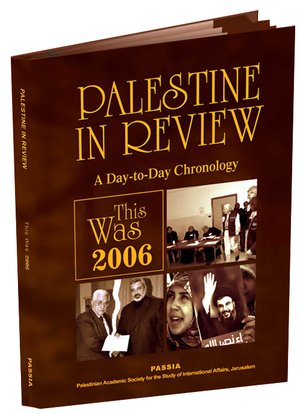Palestine in Review – This Was 2006 A Day-to-Day Chronology
Overview
Dr. Mahdi Abdul Hadi
Head of PASSIA, Jerusalem
The Palestinian Academic Society for the Study of International Affairs (PASSIA) has dedicated nearly 20 years to recording and documenting the unfolding history of the Palestinians. In doing so, PASSIA has covered a plethora of subjects ranging from settlement policies in Jerusalem to historical examinations and political analysis.
This Was 2006 marks the seventh year that PASSIA has published its annual historical review book series. These volumes are compiled with the intent to simultaneously preserve and highlight the daily internal and external struggles of the Palestinian people. By reminding the reader of the unfolding events in Jerusalem, Palestine, the Middle East region, and around the world, PASSIA hopes to record the reality shaping life in the occupied Palestinian Territories.
2006 witnessed significant changes in both the Palestinian and Israeli political landscapes. The year began with Israeli Prime Minister Sharon being incapacitated by a massive stroke and his deputy Ehud Olmert being appointed Acting Prime Minister. The year also ushered in elections for the Palestinian Legislative Council (PLC) in which Palestinians in the Gaza Strip and the West Bank and limited number of Jerusalemites voted for the second time, the first was in 1996, to select their representatives for the PLC. The victory of Hamas’ Change and Reform Party in the elections, which had a turnout of 77.69%, was a ‘political earthquake’ in Palestinian politics and a major setback for the secular Fateh movement, which had been the dominant party for decades.
In March, the Israeli army raided the Palestinian Authority’s (PA) prison in Jericho immediately after the withdrawal of United States (US) and British monitors. After a 9 ½-hour siege, six senior Palestinian prisoners surrendered to Israeli troops, most prominent among them PFLP leader Ahmed Saadat, while two PA policemen were killed, several others were wounded, and 250 Palestinians were arrested.
Also, in March, Israeli Knesset elections brought Sharon’s newly formed Kadima party to power under the prime ministership of Ehud Olmert. Shortly thereafter, President Mahmoud Abbas (Abu Mazen) swore in the Hamas-led PA government. The US, the European Union (EU), and other international bodies formally severed all direct aid to the new government, demanding that Hamas recognize Israel, renounce terror, and honor previous PA agreements. Israel challenged the establishment and recognition of the new PA government by announcing a boycott of foreign diplomats who met with the government and detaining 27 Hamas-affiliated PA ministers, including PLC Speaker Aziz Dwaik.
In mid-2006, Fateh and Hamas, the two main political factions, adopted the National Reconciliation Document (Prisoner Document), which endorsed the people’s aspirations for a Palestinian State on the 1967 borders, and asserted the right of return of Palestinian refugees to their homes. On 12 July, following Hizbullah’s attack of an Israeli patrol near the Lebanese-Israeli border fence, Israel initiated a massive aerial and artillery bombardment of targets in Lebanon, damaging Lebanese civilian infrastructure, including Beirut’s airport. Meanwhile, Israeli incursions into Gaza continued, claiming the lives of numerous civilians.
The compiling of the dates and facts for This Was 2006 was no small feat, and we hope that this comprehensive, yet cursory, collection of events that took place in 2006 will give a snapshot of the collective Palestinian narrative. As always, the documentation of the contemporary history of Palestine was complicated, largely because of the numerous and detailed events of the Palestinian-Israeli conflict. PASSIA recognizes that it is our responsibility to compile a comprehensive list of meetings, statements, resolutions, military incursions, etc. that took place, and that this volume represents only a synopsis of the events of 2006. Others may have included additional material or excluded material found here, and we can only state that This Was 2006 represents PASSIA’s efforts at providing documentation of the year 2006.

